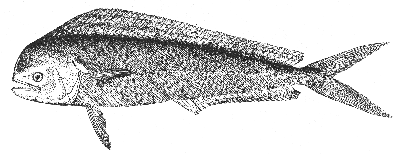Common dolphin Coryphaena hippurus Linnaeus 1758
[Jordan and Evermann, 1896-1900, p. 952.]

Figure 190.—Common dolphin (Coryphaena hippurus). From Goode. Drawing by H. L. Todd.
Description—
The dolphin differs from related fishes in that its long tapering body is most massive and deepest close behind the head, and that its dorsal fin, originating over the gill cover, extends back nearly to the base of its deeply [page 361] forked tail fin. These characters, with its sidewise flattened form, notably steep forehead, deeply forked tail, and large ventral fins, separate it at a glance from the few other Gulf of Maine fishes which have long dorsal fins with bodies that are deepest forward. Its anal fin, 26 to 30 rays, originating about midway of its body, is about half as long and half as high as the dorsal which has 55 to 65 rays. The lobes of its deeply forked tail are long and slender. Its moderately long ventrals and pectorals are situated the one below the other.
Color—
The dolphin is famous for its brilliant hues and for the vivid waves of color that flash across it when first taken from the water. Alive, in the sea, its sides are largely vivid blue, variously mottled and washed with gold; its tail largely golden yellow.
Size—
Maximum length about 6 feet.
Habits—
The dolphin, despite its blunt snout, is one of the swiftest of fishes. Voyagers on tropic seas often see them leaping in pursuit of small fry, or when pursued themselves by larger fishes. In sailing ship days dolphins were often caught by trolling from the stern. Offshore, they feed largely on flying fish; the Sandwich specimen mentioned later had some silversides in its stomach.
General range—
Cosmopolitan in warm seas; northward along our Atlantic Coast to southern New England, where it is rare inshore, occasionally straying as far as the outer coast of Nova Scotia.
Occurrence in the Gulf of Maine—
A dolphin about 31/2 feet long (now in the collection of the Boston Society of Natural History) and weighing 23 pounds, taken 60 miles south-southwest of Cape Sable, in the deep gully between Browns and Georges Banks by the trawler Natalie Hammond, August 15, 1930, was the first record for the Gulf of Maine; a second was taken in a trap at North Truro on Cape Cod Bay, in August 1949[6] (a season when many were taken off Marthas Vineyard); a third at Sandwich, on the southern shore of Cape Cod Bay in mid-July 1951.[7]